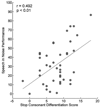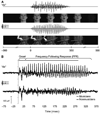Sensory-cognitive interaction in the neural encoding of speech in noise: a review
- PMID: 21241645
- PMCID: PMC3075209
- DOI: 10.3766/jaaa.21.9.3
Sensory-cognitive interaction in the neural encoding of speech in noise: a review
Abstract
Background: Speech-in-noise (SIN) perception is one of the most complex tasks faced by listeners on a daily basis. Although listening in noise presents challenges for all listeners, background noise inordinately affects speech perception in older adults and in children with learning disabilities. Hearing thresholds are an important factor in SIN perception, but they are not the only factor. For successful comprehension, the listener must perceive and attend to relevant speech features, such as the pitch, timing, and timbre of the target speaker's voice. Here, we review recent studies linking SIN and brainstem processing of speech sounds.
Purpose: To review recent work that has examined the ability of the auditory brainstem response to complex sounds (cABR), which reflects the nervous system's transcription of pitch, timing, and timbre, to be used as an objective neural index for hearing-in-noise abilities.
Study sample: We examined speech-evoked brainstem responses in a variety of populations, including children who are typically developing, children with language-based learning impairment, young adults, older adults, and auditory experts (i.e., musicians).
Data collection and analysis: In a number of studies, we recorded brainstem responses in quiet and babble noise conditions to the speech syllable /da/ in all age groups, as well as in a variable condition in children in which /da/ was presented in the context of seven other speech sounds. We also measured speech-in-noise perception using the Hearing-in-Noise Test (HINT) and the Quick Speech-in-Noise Test (QuickSIN).
Results: Children and adults with poor SIN perception have deficits in the subcortical spectrotemporal representation of speech, including low-frequency spectral magnitudes and the timing of transient response peaks. Furthermore, auditory expertise, as engendered by musical training, provides both behavioral and neural advantages for processing speech in noise.
Conclusions: These results have implications for future assessment and management strategies for young and old populations whose primary complaint is difficulty hearing in background noise. The cABR provides a clinically applicable metric for objective assessment of individuals with SIN deficits, for determination of the biologic nature of disorders affecting SIN perception, for evaluation of appropriate hearing aid algorithms, and for monitoring the efficacy of auditory remediation and training.
American Academy of Audiology.
Figures







Similar articles
-
A neural basis of speech-in-noise perception in older adults.Ear Hear. 2011 Nov-Dec;32(6):750-7. doi: 10.1097/AUD.0b013e31822229d3. Ear Hear. 2011. PMID: 21730859 Free PMC article.
-
Perception of speech in noise: neural correlates.J Cogn Neurosci. 2011 Sep;23(9):2268-79. doi: 10.1162/jocn.2010.21556. Epub 2010 Aug 3. J Cogn Neurosci. 2011. PMID: 20681749 Free PMC article.
-
Subcortical rather than cortical sources of the frequency-following response (FFR) relate to speech-in-noise perception in normal-hearing listeners.Neurosci Lett. 2021 Feb 16;746:135664. doi: 10.1016/j.neulet.2021.135664. Epub 2021 Jan 23. Neurosci Lett. 2021. PMID: 33497718 Free PMC article.
-
Enhanced brainstem phase-locking in low-level noise reveals stochastic resonance in the frequency-following response (FFR).Brain Res. 2021 Nov 15;1771:147643. doi: 10.1016/j.brainres.2021.147643. Epub 2021 Aug 30. Brain Res. 2021. PMID: 34473999 Free PMC article. Review.
-
Objective neural indices of speech-in-noise perception.Trends Amplif. 2010 Jun;14(2):73-83. doi: 10.1177/1084713810380227. Trends Amplif. 2010. PMID: 20724355 Free PMC article. Review.
Cited by
-
Effects of stimuli and contralateral noise levels on auditory cortical potentials recorded in school-age children.PLoS One. 2025 Jan 22;20(1):e0317661. doi: 10.1371/journal.pone.0317661. eCollection 2025. PLoS One. 2025. PMID: 39841711 Free PMC article.
-
Musical training, individual differences and the cocktail party problem.Sci Rep. 2015 Jun 26;5:11628. doi: 10.1038/srep11628. Sci Rep. 2015. PMID: 26112910 Free PMC article.
-
Noise Disturbance and Well-Being in the North of Spain.Int J Environ Res Public Health. 2022 Dec 8;19(24):16457. doi: 10.3390/ijerph192416457. Int J Environ Res Public Health. 2022. PMID: 36554336 Free PMC article.
-
Auditory Mismatch Negativity in Youth Affected by Autism Spectrum Disorder With and Without Attenuated Psychosis Syndrome.Front Psychiatry. 2020 Nov 24;11:555340. doi: 10.3389/fpsyt.2020.555340. eCollection 2020. Front Psychiatry. 2020. PMID: 33329094 Free PMC article.
-
Comparing Clinically Applicable Behavioral and Electrophysiological Measures of Speech Detection, Discrimination, and Comprehension.Trends Hear. 2022 Jan-Dec;26:23312165221139733. doi: 10.1177/23312165221139733. Trends Hear. 2022. PMID: 36423251 Free PMC article.
References
-
- Ahissar M. Dyslexia and the anchoring-deficit hypothesis. Trends Cogn Sci. 2007;11:458–465. - PubMed
-
- Ahissar M, Hochstein S. The reverse hierarchy theory of visual perceptual learning. Trends Cogn Sci. 2004;8:457–464. - PubMed
-
- Ahissar M, Lubin Y, Putter-Katz H, Banai K. Dyslexia and the failure to form a perceptual anchor. Nat Neurosci. 2006;9:1558–1564. - PubMed
-
- Aiken SJ, Picton TW. Envelope and spectral frequency-following responses to vowel sounds. Hear Res. 2008;245:35–47. - PubMed
-
- Anderson S, Parbery-Clark A, Skoe E, Kraus N. Brainstem correlates of speech in noise in older adults; Poster presented at Aging and Speech Communication: Third International and Inter-disciplinary Research Conference; October 12–14; Indiana University, Bloomington, IN. 2009.
Publication types
MeSH terms
Grants and funding
LinkOut - more resources
Full Text Sources
Medical
